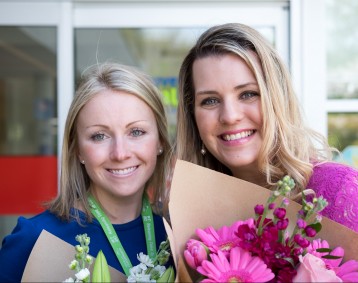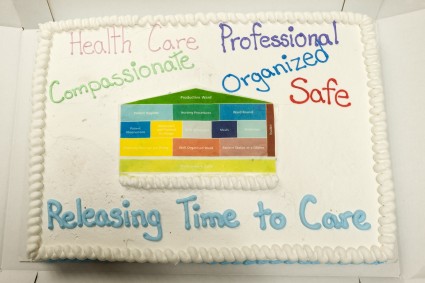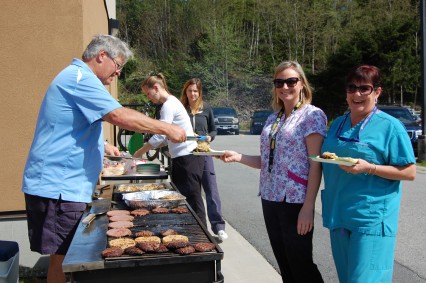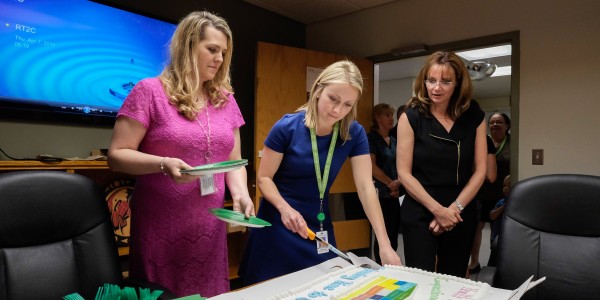Squamish General Hospital first VCH site to complete RT2C modules
Squamish General Hospital achieved a major milestone last week – it was the first VCH site to complete all Releasing Time to Care modules (RT2C) on its medical/surgical ward. The achievement – four years in the making – was celebrated with a sun-splashed lunchtime BBQ, a colossal-sized cake and heaping amounts of heartfelt praise for the dedicated staff.
“This type of success takes commitment, teamwork and a significant amount of effort on the part of staff,” wrote Kip Woodward, VCH Board Chair, in a letter to staff. “It’s important you know that the board is aware and very much supportive of your noteworthy contributions.”
Started in the UK
Created by the UK’s National Health Service, RT2C is a program designed to free up clinical staff time from onerous, time-consuming functional tasks so that they can focus on the important work: patient care.
Using concepts similar to “Lean,” the grass-roots program engages staff in their own environment where they can bring forward real issues for discussion and resolution. Issues can be large or small, but resolving them relies on safe, open conversation about the issues that affect the quality and efficiency of the unit. Ideas are generated by the team. Priorities are identified by the team. Responsibilities are shared by members of the team.
Meet Jacquie and Marcia
Initiating the RT2C process at SGH was Ward Lead Jacquie Steglich, RN, with LPN Marcia Kent later joining on as a Ward Lead as well. They were both singled out at last week’s celebration for their continuing passion and leadership over the last four years as they meticulously worked through each of the 11 modules with staff.

RN Jacquie Steglich and LPN Marcia Kent – RT2C Ward Leads at Squamish General Hospital.
“It’s been an incredible journey,” says Jacquie, “and this achievement is a testament to the dedication of our staff to the patients that we care for. We have an incredible collaborative team to be proud of. Patient safety has always been our priority and by seeing the decrease in inpatient falls and medication incidences there is proof that our efforts and interventions are effective.”
Culture change
“So many things have changed – both in our physical work environment and within our staff culture,” says Jacquie. “Our nursing staff now collects our own data, which helps all of us to have an increased awareness of patient-specific safety events within our facility. The project has provided staff with a venue to voice concerns and ideas for improvement and has facilitated interdisciplinary involvement. By streamlining processes and reorganizing our physical environment we are able to spend more time with what matters most – the patients.”
Pride and joy
Laurie Leith, Operations Director, Coastal (Sea to Sky), is effusive in her praise for the SGH team and the positive impact RT2C has had on staff.
“The most positive aspects of RT2C has been that it’s staff driven/led and how it’s relevant to staff’s day-to-day work, which provides greater personal and professional satisfaction, as well as, patient satisfaction,” says Laurie. “I’ve enjoyed watching the transformation that has occurred over the years on the unit – for example better layout and access to patient care supplies, medications, etc. And seeing how proud the staff are of their various achievements.”
Seeing life through a new lens
Cindy Sellers, Sea to Sky Acute Services Manager, says RT2C has forever altered how staff now work at SGH.
“RT2C has become our normal way of life here and how we approach all of our work,” says Cindy. “All new initiatives are looked at through the RT2C lens to view the impact they’ll have on time away from patients. We have a very clear process for problem solving and solutions are usually staff generated.”
Personal satisfaction
While each person has their own special area of improvement they’re proud of, Marcia is particularly proud of the Activities Centre, which was created for many of the elderly patients awaiting placement to a care facility.
“As a team, we brainstormed the idea of creating activities that could help improve upon their stay and most importantly their overall well-being. Our Activities Centre was created based on careful research, sourcing advice from team members, and by interviewing patients themselves,” says Marcia. “Since our patients have had access to activities like busy boards, music therapy and games, we’ve reduced the use of medications for calming dementia patients, reduced patient wandering/falls and, most importantly, the well-being of our patients.”
Next Steps
“While we’ve essentially ‘completed’ all of the requirements for each of the modules the project is not yet done for us,” says Jacquie. “Many improvements will need to be sustained and, in an effort to keep pace with the growing population in Squamish, additional improvements will need to be made.”
Marcia agrees.
“Every department of our hospital has contributed to the success of RT2C,” says Marcia. “We’ve come a long way since starting four years ago and still have lots to sustain. We must be constantly reevaluating and revisiting areas we can keep improving on to continue growing.”

A colossal cake for a colossal achievement. SGH staff and visitors gobbled up the gateau that was brought in to celebrate completion of the RT2C modules at the hospital.

Squamish General Hospital staff enjoy a BBQ to celebrate the completion of the RT2C modules.

